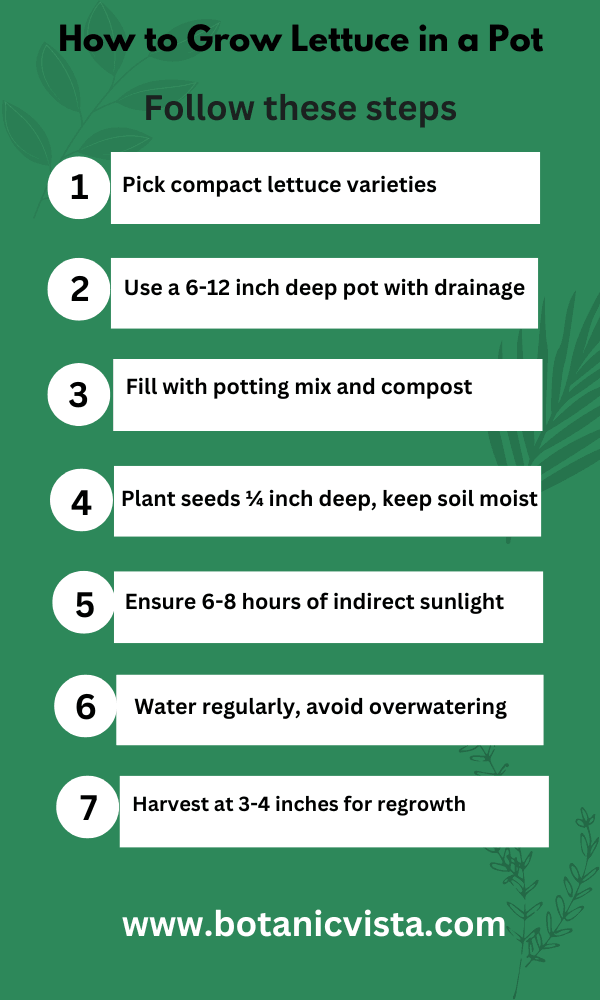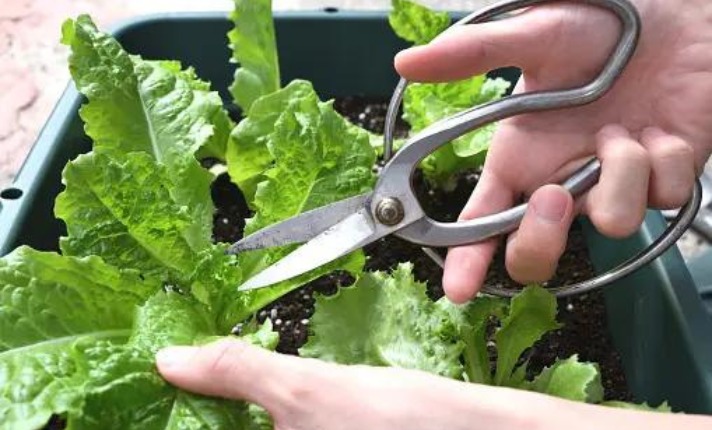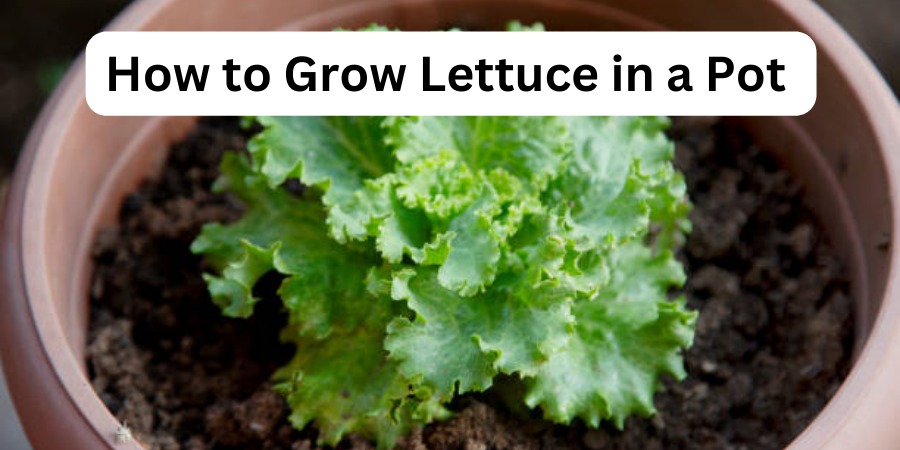Last Updated on October 11, 2024 by Jocelyn
Growing lettuce in a pot is a perfect way to enjoy fresh greens at home. It’s easy and quick to start, even for a beginner gardener. Choose a large pot and fill it with good soil. Planting seeds about 1/4 inch deep will get you started.
Place the pot in a cool, indoor spot with plenty of light. This helps control the growing conditions and produce bountiful crops. Water regularly to keep the soil moist. Soon, you’ll see the leaves sprouting.
Growing lettuce on porches, balconies, or patios is convenient and perfect for urban spaces. Even in small areas, you can produce plenty of greens. Enjoy the process and the fresh taste of homegrown lettuce.

Table of Contents
ToggleChoosing the Right Lettuce Variety
When you grow lettuce in a pot, choosing the right kind is essential. First, choose a variety that suits your taste and growing conditions. Romaine and butterhead are popular choices for their delicious and crunchy leaves.
Looseleaf lettuce is easy to grow and comes in beautiful and colorful varieties. Mesclun offers a mix of baby greens that are great for salads. Iceberg lettuce is sturdy and crisp, making it perfect for a hamburger or sandwich.
Selecting the Best Container
Choosing the right container is important for growing healthy lettuce. Use plastic, clay, or fabric grow bags with drilled holes for drainage. Ensure the container is 12-16 inches deep to give the roots enough space.
Here’s how to get started and make the most of your container garden.
- Ideal Container Size
For different types of lettuce, the container size matters. Loose-leaf lettuce grows well in containers that are 6 inches deep and 12 inches wide. Head lettuce needs deeper containers, around 8-10 inches deep and 12-16 inches wide, to allow the roots to develop properly.
- Importance of Drainage Holes
Drainage holes are essential to prevent waterlogging. They allow excess water to escape, ensuring the roots don’t stay too wet. This helps maintain healthy and strong roots.
- Best Materials for Containers
Select containers made from plastic, clay, or fabric grow bags. Plastic containers are light and durable. Clay pots are porous, allowing air to circulate around the roots, but they can be heavy. Fabric grow bags are eco-friendly and promote excellent root aeration.
- Mobility and Placement
Consider the mobility of your containers. Use pots with handles or wheels for easy movement. Place them in areas with consistent sunlight, like a windowsill or patio. This allows you to move the plants indoors during extreme weather conditions.
Preparing the Potting Soil
First, get a high-quality potting mix. Make sure it is lightweight and well-draining. You can use pre-mixed potting soil or customize it with compost, perlite, and vermiculite. This balance helps the soil stay moist but not too wet.
For container gardening, choose a container that holds at least 3 ½ gallons. You can use a wine barrel or a raised bed. Ensure it has good drainage to prevent root rot. A professional soil mix with organic matter like peat and compost is ideal.
Use a scoop to fill the container with soil. Make sure the soil is fertile and rich in nitrogen to support foliage growth. Avoid over-watering to prevent issues with pests and diseases.
Add a layer of well-draining soil on top. This helps with water absorption and prevents a crust from forming. The soil should be fertile and have good water retention. This makes the lettuce grow better and taste sweeter.
Incorporate nutrients into the soil by adding compost and fertilizer. This ensures the lettuce gets all the nutrients it needs to grow robust and healthy. Using organic matter will help maintain soil quality.
Planting Lettuce Seeds in Pots
Lettuce seeds are tiny and delicate. Selecting the right variety depends on the time of year. Loose-leaf is the easiest and matures in a shorter time.
Step-by-Step Guide to Sowing Lettuce Seeds
- Fill the pot with well-draining potting soil.
- Sprinkle the seeds on the soil’s surface.
- Plant the seeds 1/4 inch deep.
- Space the seeds 4-6 inches apart in rows.
- Keep the rows 8 inches apart for best results.
- Lightly press the seeds into the soil.
- Cover the seeds with a fine layer of potting soil.
Tips for Indoor vs. Outdoor Planting
Indoor Planting
- Start the seeds indoors in a plastic garden tray.
- Begin 3-4 weeks before the last frost.
- Use high-quality seeds for a higher germination rate.
- Keep the soil moist and place the tray in a sunny spot.
Outdoor Planting
- Transfer the seedlings to containers outside after the last frost.
- Choose a cool spot, as lettuce grows best in early spring.
- Thin the seedlings to allow space for multiple plants.
Ready to grow more veggies/flowers in pots? Check out my guides:
Optimal Growing Conditions
To successfully grow lettuce in a pot, it’s important to focus on key factors like soil quality, watering practices, and pest control. By providing the right conditions, you can enjoy a healthy and productive crop of lettuce.
Here’s a simple guide to help your lettuce grow:
| Step | Details |
| Soil | Use composted soil with good drainage. |
| Sunlight | Needs 4-6 hours of sunlight each day, prefers partial shade in the afternoon. |
| Watering | Water deeply and keep hydrated. Avoid overwatering. |
| Fertilizer | Apply balanced fertilizer to provide nutrients. |
| Temperature | Ideal temperature is between 45°-80°F. |
| Protection | Use an umbrella or cold frames to protect from frost. |
| Pests | Control aphids, slugs, and snails with natural methods. |
Companion Planting
Companion planting helps lettuce act against pests. Mint and garlic can help; they repel insects.
Parsley and marigolds are good too. They create a diverse environment, keeping the soil healthy. When you plant lettuce with them, it grows better. Allowing these plants to grow together can help the garden.
Radishes and carrots are great companions. They use different resources from the soil. Chives and cilantro are helpful too, as they repel pests like aphids and slugs.
Ladybugs and other beneficial insects are important. They eat pests. Planting herbs like mint and cilantro helps attract them.
Pest and Disease Management
To keep your lettuce healthy, it’s essential to monitor and manage pests effectively. Using a combination of natural and practical methods ensures your plants stay strong and free from damage. Here’s how you can protect your lettuce from common garden pests
| Method | Description |
| Beer traps | Fill a shallow bowl or pie pan with beer. The smell lures slugs, and they drown. |
| Copper tape | Wrap copper tape around your pot. It acts as a barrier to keep slugs and snails away. |
| Hand-picking | Regularly check for critters and aphids. Remove them by hand and place them in soapy water. |
| Neem oil | Spray neem oil on your plants. It helps control pests naturally. |
| Soap solution | Use a soap solution to spray on small pests like aphids. It disrupts their cells and ultimately kills them. |
Want to grow more vegetables in containers? Check out my guides:
Pruning and Maintenance
When your lettuce plants start growing, you’ll see outer leaves. Pruning these leaves helps the plant produce new leaves. To keep your lettuce healthy, prune any dead or damaged leaves. This also prevents overcrowding.
For regular maintenance tips, make sure to check your plants often. Remove any bad leaves to help new ones grow. This simple pruning helps promote healthy growth.

Harvesting Lettuce
After weeks of growth, lettuce develops a rosette shape. The outer leaves can be snipped for a salad. Keep the leaves clean and washed. This variety of lettuce can be harvested frequently. Use sharp scissors or a knife. Cut the leaves close to the base. New leaves will grow back tender and plump.
Lettuce needs clean soil and regular watering to stay hydrated. Water in the morning to avoid wilting. Keep the soil moist but not too wet. This helps prevent bolting and ensures a good flavor. To encourage healthy growth, snip young leaves frequently. This method, called cut-and-come-again, produces tender leaves. Continue harvesting and enjoy fresh salad regularly.
Use a sharp knife or scissors for snipping. Harvest in the morning when leaves are fresh. Keep leaves clean and washed with a spinner. Lettuce can typically be harvested multiple times.
FAQ’s
Q: How Big of a Pot Do I Need for Lettuce?
A: To grow lettuce in a pot, choose a container that’s 6-12 inches deep and wide. Lettuces can grow well in shallow pots with a depth of around six inches. A diameter of three inches is the minimum, but four inches or more is ideal.
Q: How Often Do You Water Lettuce in Pots?
A: Water lettuce plants twice a week for the best results. Seedlings need watering every other day. Once sprouted, check soil moisture daily.
Q: What Is the Best Potting Mix for Lettuce?
A: The best potting mix for growing lettuce in a pot is a blend of compost, sand, and loam. This mix provides good drainage, retains moisture, and prevents waterlogging. Adding perlite helps keep the soil airy and the roots healthy.
Q: Does Lettuce Need Direct Sunlight?
A: Lettuce needs 4 to 6 hours of sunlight each day. Partial shade is fine, especially in hot areas. Make sure it gets some sun for best growth.
Q: What Is the Best Fertilizer for Lettuce?
A: Organic garden fertilizers like alfalfa meal and kelp meal are great. Use compost tea or seaweed extract for added nutrients. For quick results, try MiracleGro or Osmocote.
Conclusion
Growing lettuce in a pot at home is an easy way to enjoy fresh, delicious greens. Choose the right pot with good drainage and use a well-draining soil mixture. Give your lettuce plenty of sunlight and water. Watch out for slugs and snails; using copper tape or beer traps can help keep them at bay.
Remember to harvest the leaves when they’re long enough, and enjoy your home-grown salads. This method is practically space-saving and can produce a bountiful crop with just a little care and patience. Enjoy your nutritious, organic lettuce all season long!

